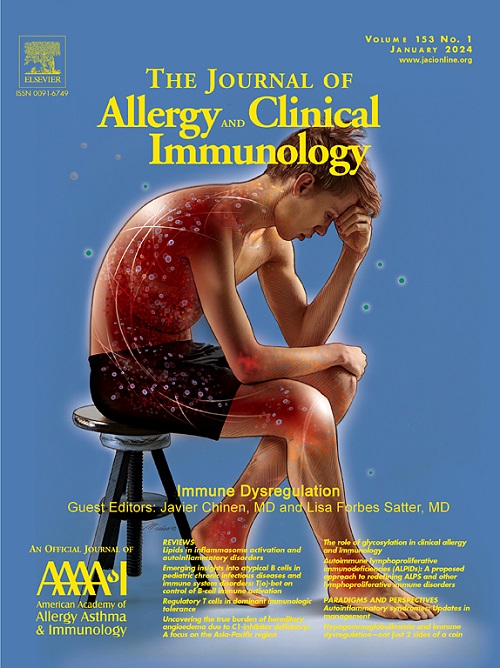Sputum short-chain fatty acids, microbiome, inflammation, and mucus plugging in obstructive airway disease
IF 11.4
1区 医学
Q1 ALLERGY
引用次数: 0
Abstract
Background
Short-chain fatty acids (SCFAs), produced by anaerobic bacteria through fermentation in the gut, may suppress eosinophilic inflammation while potentially promoting neutrophilic inflammation. However, the role of local SCFAs in the airway microbiome, inflammation, and mucus plugging in type 2–dominant obstructive airway diseases remains unclear.
Objective
Our aim was to investigate associations between sputum SCFAs and the relative abundance of anaerobic bacteria, neutrophil and eosinophil counts in sputum, and mucus plug scores on computed tomography images in patients with obstructive airway diseases.
Methods
Sputum samples and chest computed tomography images were prospectively collected in stable patients with asthma with fixed airflow limitation, chronic obstructive pulmonary disease, and asthma–chronic obstructive pulmonary disease overlap (ACO). Sputum samples were analyzed for concentrations of SCFA, including n-butyrate, acetate, and propionate; microbiome composition using 16S rRNA sequencing; and inflammatory cell differentials.
Results
In 46 patients, enriched for ACO with relatively high levels of type 2 markers, higher SCFA levels were associated with higher relative abundance of bacteria of the phylum Bacteroidetes and lower relative abundance of bacteria of the phylum Proteobacteria. Hierarchic clustering identified a severe eosinophil-dominant inflammation cluster characterized by lower SCFAs levels and higher mucus plug scores. In the 2 neutrophilic clusters, one characterized by higher SCFAs levels and the other by lower SCFAs levels, lower butyrate levels were significantly associated with higher mucus plug scores.
Conclusion
Local SCFA concentrations may be closely associated with the airway microbiome and influence mucus plugging in ACO-enriched populations. Understanding these interactions could inform therapeutic strategies targeting SCFAs or the microbiome to manage type 2–dominant obstructive airway diseases.
痰短链脂肪酸、微生物群、炎症和粘液堵塞阻塞性气道疾病。
背景:短链脂肪酸(SCFAs),由厌氧菌通过肠道发酵产生,可能抑制嗜酸性粒细胞炎症,同时可能促进嗜中性粒细胞炎症。然而,在2型显性阻塞性气道疾病中,局部SCFAs在气道微生物组、炎症和粘液堵塞中的作用尚不清楚。目的:探讨阻塞性气道疾病患者痰中SCFAs与厌氧菌相对丰度、痰中中性粒细胞和嗜酸性粒细胞计数及粘液堵塞CT评分的关系。方法:前瞻性采集稳定型哮喘伴固定气流受限、慢性阻塞性肺疾病(COPD)、哮喘-COPD重叠(ACO)患者的痰液及胸部CT。分析痰样本的SCFAs浓度,包括正丁酸盐、乙酸盐和丙酸盐,使用16S rRNA测序分析微生物组组成,以及炎症细胞差异。结果:在46例富含ACO且2型标记物相对较高的患者中,较高的SCFA水平与较高的拟杆菌门相对丰度和较低的变形菌门相对丰度相关。分层聚类鉴定出严重的嗜酸性粒细胞为主的炎症集群,其特征是较低的scfa水平和较高的粘液堵塞评分。在两个嗜中性粒细胞集群中,一个以较高的SCFAs水平为特征,另一个以较低的SCFAs水平为特征,较低的丁酸盐水平与较高的粘液堵塞评分显著相关。结论:在aco富集人群中,局部SCFA浓度可能与气道微生物组密切相关,并影响粘液堵塞。了解这些相互作用可以为针对scfa或微生物组的治疗策略提供信息,以管理2型显性阻塞性气道疾病。
本文章由计算机程序翻译,如有差异,请以英文原文为准。
求助全文
约1分钟内获得全文
求助全文
来源期刊
CiteScore
25.90
自引率
7.70%
发文量
1302
审稿时长
38 days
期刊介绍:
The Journal of Allergy and Clinical Immunology is a prestigious publication that features groundbreaking research in the fields of Allergy, Asthma, and Immunology. This influential journal publishes high-impact research papers that explore various topics, including asthma, food allergy, allergic rhinitis, atopic dermatitis, primary immune deficiencies, occupational and environmental allergy, and other allergic and immunologic diseases. The articles not only report on clinical trials and mechanistic studies but also provide insights into novel therapies, underlying mechanisms, and important discoveries that contribute to our understanding of these diseases. By sharing this valuable information, the journal aims to enhance the diagnosis and management of patients in the future.

 求助内容:
求助内容: 应助结果提醒方式:
应助结果提醒方式:


